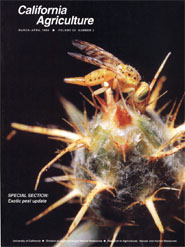Calag Archive
Calag Archive

Special Edition: Exotic pest update
Cover:
Though accidently introduced to California, the false peacock fly may be a powerful new weapon against yellow starhistle, the state's most widespread weed. Scientists are also testing bio-controls, herbicides and mowing. Photo by Gerry Johnson
March-April 1999
Volume 53, Number 2
Volume 53, Number 2
News and opinion
PEER-REVIEWED
Two new seed head flies attack yellow starthistle
The larvae of the peacock fly and the accidentally introduced false peacock fly feed inside the seed head of yellow starthistle, destroying its seeds.


